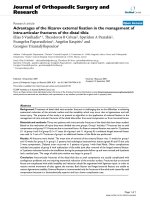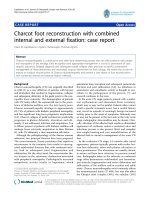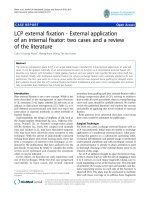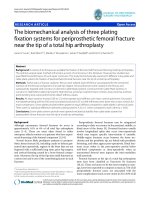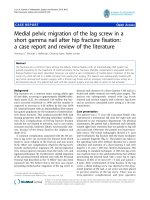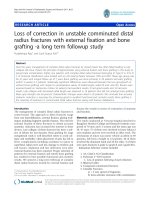External fixation unstable pelvic fracture
Bạn đang xem bản rút gọn của tài liệu. Xem và tải ngay bản đầy đủ của tài liệu tại đây (388.93 KB, 8 trang )
Journal of military pharmaco-medicine no3-2019
EXTERNAL FIXATION OF UNSTABLE PELVIC FRACTURE
Nguyen Van Ninh1; Nguyen Tien Binh2
Pham Dang Ninh3; Nguyen Ba Ngọc3
SUMMARY
Objectives: To give some remarks on treatment results of the unstable fractures of the pelvic
ring by external fixation on the prevention of shock, anatomical recovery and rehabilitation. Also,
we gave some comments on indications, techniques and complications. Subjects and methods:
71 patients with unstable fractures of the pelvic ring type B and type C according to Tile M’s
classification were treated by external fixation at 103 Military Hospital and National Institute of
Burns from May 2010 to Feb 2017. Among them, we conducted a prospective study on 49 patients
and a retrospective one on 22 patients. External frame by the reversed pressed bars by profesor
Nguyen Van Nhan, four Ø 4.5 mm Schanz pins are placed in the illiac crests. Early results:
69 patients became stable, out of shock (97%); 2 deaths due to shock; reduction: good 56
patients (78.9%), fair: 8 patients (11.3%), average: 4 patients (5.6%); poor: 3 patients (4.2%).
After fixation, patients had less pain and could recover quickly. Far results: 62 patients
(87.32%), follow-up from 6 to 78 months, average 33.74 months. 100% of pelvic fratures are
healed. The functional outcome was evaluated by using a scoring system by Majeed (1989).
Clinical findings: Good 52 patients (83.9%); fair 3 patients (4.8%); average 4 patients (6.5%);
poor 3 patients (4.8%). Conclusion: Treatment of unstable pelvic fracture by the external fixation
had good results with simple, easy procedure. Pelvic fracture was fixed firmly to reduce the pain,
stop bleeding, prevent shock, convenient for treating the patient.
* Keywords: Unstable pelvic fractures; External fixation.
Pelvic facture is a common injury and
is usually severe. According to Melton’s
statistics (1981) in 10 years (1968 - 1977)
at Minnesota, there was an estimated
37 patients/100.000 persons/1 year suffering
from pelvic fracture [1]. In Vietnam,
according to Ngo Bao Khang (1995) in
Cho Ray Hospital, pelvic facture ranged
from 3 - 5% of total bones facture [1].
lesions, so the mortality rate was so high.
Main cause was due to traffic accidents.
Lindahl (1999) did a research on 110 patients
with unstable pelvic fracture treated by
external fixator frames, among whom,
62% related to traffic accidents, 28% of
high falls, and 10% from high powerful
trauma, mortality rate was 12% [7]. In
Vietnam, according to Ngo Bao Khang [1]
(1995) and Nguyen Duc Phuc (2004) [2],
50% were due to traffic accidents.
Pelvic fractures are often in the context
of multiple injuries and often with combined
The classic treatment for pelvic fracture
allows the patient to lie motionless,
INTRODUCTION
1. 91 Hospital
2. Military Medical University
3. 103 Military Hospital
Corresponding author: Nguyen Van Ninh ()
Date received: 30/11/2018
Date accepted: 15/02/2019
132
Journal of military pharmaco-medicine no3-2019
to bandage around the pelvis, traction...,
although it is simple and easy to do.
However, the results of recovery of
anatomy are not good, patients remain
immobile for a long time.
Internal fixation give good results of
recovery of anatomy, the patients can
move early, avoid the complications
because of motionlessness for a long
time, but it is a complicated surgery, this
technique can not be done in the emergency
stages and with open pelvic fractures.
In recent years, the devices for external
fixation have become popular for the
treatment of unstable injuries of the pelvic
ring. Compared with conservative treatment,
this technique brought better results but
anterior external fixation frame soon
exposed its limitations when used for the
most unstable injuries, especially in the
posterior part of the pelvic ring [3, 4, 8, 9].
Pelvic fractures cause a lot of blood
loss, the patient is very painful, often
shocking. Therefore, there have been many
foreign and domestic surgeons using
external fixator frames for emergency
pelvic fracture treatment for the purpose
of correction and fixation of pelvic fractures,
preventing shock, facilitating the management
of combined lesions and prophylaxis
complications. Over the years, the Department
A
of Orthopedics and Trauma, 103 Military
Hospital has applied external fixation
method by the reverse threaded pressed
rods by Nguyen Van Nhan to treat pelvic
fractures and obtained very satisfactory
results [3]. We study this subject aiming:
- To assess the results of treament of
unstable pelvic fracture by external fixation on
anatomical recovery and funtional outcome.
- To give some remarks about the
indication and technique.
SUBJECTS AND METHODS
1. Subjects.
Between May 2010 and Feb 2017, we
treated 71 consecutive patients with an
unstable fracture of the pelvic ring by
closed reduction and a external fixator.
Among 71 patients, there were 41 women
and 30 men.
2. Methods.
- Prospective study on 49 patients and
retrospective study on 22 patients.
- Instruments for external fixation:
+ 2 reverse threaded pressed rods of
Nguyen Van Nhan (35 cm in length).
+ 4 Schanz pins: 4.5 x 180 mm in diameter.
+ Driller by hand and electrical driller,
diameter of drill = 3.5 mm.
B
Figure 1: A. Instruments for external fixation. B. Model of unstable pelvic fracture.
(Source: the images from the research)
133
Journal of military pharmaco-medicine no3-2019
* Technique:
Drill and insert 2 Schanz pins (diameter 4.5 mm, length 180 mm) into each iliac
crest, distance between 2 pins was 3 - 4 cm. Installed 2 reverse threaded pressed rods
with the Schanzs, then linking two rods by two Steinman pins (diameter 4.5 x 100 mm
length) make the exteral fixator frame.
Use the wrench 10 to turn gradually, to press the surface of the pelvic fractures or
joints close together. X-ray was taken when the patient's body was stabilized to correct
displacement of the pelvic fractures or joints. The external fixator frame was maintained
8 - 10 weeks.
Figure 2: External fixation frame.
(Source: the images from the reseach)
* Evaluation of outcome:
The functional outcome was measured
using a scoring system described by Majeed
(1989), which is based on the clinical
examination [10].
Functional outcome (total score): good
> 85; fair: 70 - 84; average: 55 - 69 and
poor < 55.
* Statistical analysis: by SPSS software
16.0.
RESULTS
1. Characteristics.
- Causes of injuries: Mainly by traffic
accident (39/71 patients = 54.9%); falling:
20/71 patients (28.1%) and different
accidents: 12/71 patients (17%).
134
- 37 patients had shock (52.1%), in
which: 20 patients (28.2%) were shocked
but had stable treatment at the frontal
hospital; 17 patients (23.9%) were shocked
when they came to hospital (10 cases were
treated stable, then made the external
fixation, 7 cases of emergency surgery
were fixed external frame: 5 cases got
over shock and returned stability, 2 deaths
from other organ diseases).
- We used Tile M’s classification (2003)
[9]: type B1 + B3 (open book pelvic fracture:
22 patients = 30.9%). type B2 (close book
pelvic fracture: 36 patients = 50.7%). Type
C: Completely unstable fracture: 13 patients
= 18.3%.
Journal of military pharmaco-medicine no3-2019
2. Combined lesions.
3. Early results.
- 14 cases had brain injury (2 cases of
brain trauma had surgery).
- 8 cases suffered from closed abdominal
trauma: rupture of the rectum: 3 cases,
rupture of the small intestine: 1 case.
- 10 cases had large retroperitoneal
hematoma.
- 8 cases had closed thoracic trauma.
- 12 cases had urology trauma: Urethral
rupture in men (2 cases); bladder rupture
(4 cases); vaginal discharge (2 cases);
muscul tissues wounds (4 cases).
X-ray examination after external fixation
noticed that the anatomical recovery of
pelvis of 69 patients, in which good level:
56 patients (81.2%); fair level: 8 patients
(11.6%); average level: 2 patients (2.9%);
poor level: 3 patients (4.3%).
The technique of fixation achieved 100%.
Convenient for taking care and treating
the rerated injuries.
Schanz pins were in the correct position,
in the bone of the iliac crests.
- 42 cases had other bones or joints
injury.
The time for healing pelvic fractures and
releasing the frame: 8.45 weeks.
- 2 cases had burn: 1 case of electrical
burn with 17% of head, face, neck, body.
1 case of gas burn with 60% of face,
neck, body, legs.
Complications of Schanz pins infection:
22/69 patients (31.0%), 51/276 pins (18.47%).
Infections were treated (grade III): 8/51 pins
(16%).
Table 1: Anatomical recovery results (n = 69).
Anatomical recovery results
Classification
Total
Good
Fair
Average
Poor
(n, %)
(n, %)
(n, %)
(n, %)
Type B1 (open book - fracture)
18 (26.1)
3 (4.3)
0 (0.0)
0 (0.0)
21 (30.4)
Type B2 (close book - fracture)
33 (47.8)
1 (1.4)
1 (1.4)
1 (1.4)
36 (52.2)
5 (7.2)
4 (5.8)
1 (1.4)
2 (2.9)
12 (17.4)
56 (81.2)
8 (11.6)
2 (2.9)
3 (4.3)
69 (100.0)
Type C
Total (n, %)
(n, %)
4. Long-term results.
- Follow-up: 62/71 patients (87.32%), 9 patients without far results (7 patients lost
address, 2 deaths).
- The time for assessing long-term results: the shortest was 6 months, the longest
78 months, average: 33.74 months (average 33.74 months).
- Functional outcome: Good: 52 patients (83.9%); fair: 3 patients (4.8%); average:
4 patients (6.5%); poor: 3 patients (4.8%).
135
Journal of military pharmaco-medicine no3-2019
Table 2: Functional outcome (n = 62).
Functional outcome
Total
Classification
Good
(n, %)
Fair
(n, %)
Average
(n, %)
Poor
(n, %)
(n, %)
Type B1 (open - book fracture)
16 (25.8)
2 (3.2)
1 (1.6)
0 (0.0)
19 (30.6)
Type B2 (close - book fracture)
29 (46.8)
1 (1.6)
1 (1.6)
1 (1.6)
32 (51.6)
Type C
7 (11.3)
0 (0.0)
2 (3.2)
2 (3.2)
11 (17.7)
52 (83.9)
3 (4.8)
4 (6.5)
3 (4.8)
62 (100.0)
Total (n, %)
5. The connection between anatomical recovery and funtional outcome (n = 62).
Table 3:
Functional outcome
Anatomical
recovery results
Total
Good
(n, %)
Fair
(n, %)
Average
(n, %)
Poor
(n, %)
(n, %)
49 (79.0)
0 (0.0)
0 (0.0)
0 (0.0)
49 (79.0)
Fair
3 (4.8)
3 (4.8)
2 (3.2)
0 (0.0)
8 (12.9)
Average
0 (0.0)
0 (0.0)
2 (3.2)
0 (0.0)
2 (3.2)
Poor
0 (0.0)
0 (0.0)
0 (0.0)
3 (4.8)
3 (4.8)
52 (83.9)
3 (4.8)
4 (6.5)
3 (4.8)
62 (100)
Good
Total
p
< 0.0001
49 patients had good anatomical recovery results and functional outcome. 3 patients
had poor anatomical recovery results and functional outcome. The connection between
anatomical recovery and funtional outcome was statistically significant, p < 0.05.
DISCUSSION
1. Indications.
According to Tile M, to choose a
treatment method for patients with pelvic
fractures must firstly be based on the
patient's overall condition and pelvic
fracture classification which is currently
being used by many surgeons. For type A
fractures (stable pelvic fractures), if there
are no associated injuries, the patient
will be immobile for 4 weeks. Type B
136
fractures (B1, B2) are not completely
unstable pelvic fractures (unstable rotation
and stable vertical) and type C, which
completely unstable fractures (both rotation
and vertical): Need to undergo surgery to
stabilize the pelvic bone, the reason we
choose the method is:
First, this is a solid fixation method,
simple, noninvasive and safe technique.
This can be done in the emergency room
and can do in the resuscitation stages.
Journal of military pharmaco-medicine no3-2019
Table 4: Some authors’ functional results.
Results
Patients
Good
Fair
Author
(n)
(n, %)
Michelangelo S [12]
41
Rommens P.M [13]
Poor
(n, %)
Average
(n, %)
(n, %)
12 (29.0)
18 (44)
7 (17)
4 (10)
122
57 (46.7)
36 (29.5)
24 (19.7)
5 (4.1)
Nguyen Ngoc Toan [5]
81
22 (27.2)
30 (37.0)
20 (24.7)
9 (11.1)
Our research
62
52 (83.9)
3 (4.8)
4 (6.5)
3 (4.8)
Thus, the results of the study are much
more different from other authors’ findings
with a good rate of 83.9%. The reason
was that our long-term follow-up averaged
33.74 months compared to 25.6 months
in Nguyen Ngoc Toan’s study and
21.6 months in Rommens P.M’s study.
this position is right under the skin, easy
to do and can avoid blood vessel damage,
organ damage in the abdomen. Some
authors also pierce the pins in the pubis,
which creates better force for frame, but
this technique requires drilling pins to
prevent the organs from the injury.
Patients with severe and complex
injuries got over shock and good functional
outcome. It demonstrates that our method
was accurate. Long-term follow-up was
done for 62/69 patients (89.8%), the
shortest was 6 months, the longest was
78 months, mean: 33.74 months.
First, drill through the pelvic shell by
countersink (diameter 3.5 mm), then use
a hand drill to catch the pins. Make sure
the pins are pierced to the iliac crest.
When using a sharp pins, they can be
pierced directly to the iliac crest and
drilled slowly. If we drill through the side
of the bony shell, the pins is no longer
firmly attached to the bone. Normally after
incision, we use the tip of pins to probe
the thickness of the iliac crest before
drilling and placing the pins in the center.
2. Technique.
We shared the same idea as European
authors that external fixation should be
done as soon as possible [7, 9], as the
important goal is to relieve pain and stop
bleeding. Therefore, if patients with combined
lesions need surgery, patients should be
placed on the operating room and fixed
pelvis after closing the abdominal surgery.
If the patient does not have intraabdominal injury, we can do at their ward
and need to do early after excluding the
abdominal emergency.
The position of Schanz pins placement:
We chose the iliac crest to insert because
We should place the frame 4 - 5 cm far
from the skin of the abdominen, which is
enough to care the abdominal incision,
if any.
Why choose the reverse threaded
pressed rods by Nguyen Van Nhan: This
is a frame that military doctors usually use
because of simple structure, solid fixation
and they are available in military hospitals.
They can be used for many fractures,
137
Journal of military pharmaco-medicine no3-2019
convenient for preservation, use in the
frontline in combat conditions or mass
rescue.
3. Anatomical recovery results.
- Reduction of type B1 pelvic fracture
(open book fracture): Patients usually
have pelvic ring injury with a symphysis
pubis dislocation and sacroiliac joint
dislocation. In this case, to reduce an
untable pelvic fractures in the inner
rotation, we must turn to press 2 rods of
external fixation together, but we must
turn gradually and alternately one by one,
1 round of rod can narrow the distance 2
mm, the reverse threaded pressed rods
by Nguyen Van Nhan can apply to treat
unstable pelvic fractures and two Ø 4.5
mm Schanz pins are inserted into illiac
crests on each side and can be reduced
and fixed firmly.
- Reduction of type B2 pelvic fracture
(close book fracture): We usually see that
the patients have this injury with pubis
fracture in anterior and dislocation of
sacroiliac joints in the posterior half of the
pelvis. Clinical results show that with B2.1
fracture, two Schanz pins are inserted
into each side of the pelvic crests can be
reduced pelvis on outer rotation and fixed
firmly.
- Reduction of type C pelvic fracture
(rotational and vertical displacement):
For this type of injury, firstly, traction to
reduce upward displacement of hemipelvis
(weight of 8 - 10 kg), X-ray to review if
hemipelvis is horizontal with the other
side, the external fixator frame is applied
to reduce the pelvis in the anatomical position.
138
- External fixation has good ability of
reduction with type B fractures, can limit a
reduction of type C pelvic fratures.
4. Functional outcome.
We agreed with European authors
about using Majeed's rehabilitation
assessment (1989) [11]. 62/69 patients
(89.9%) were followed long-term; good
and fair functional outcome: 88.7%. In the
study, most cases had good anatomical
recovery results and functional outcome.
The connection between anatomical
recovery and functional outcome was
statistically significant (p < 0.05).
CONCLUSION
- External fixation: Simple, easy to fix
the pelvic fracture, reduce pains, stop
bleeding, prevent shock and treat the
complex injuries.
- Convenient for taking care and treating
patients and could avoid the complications
occurrence while the sick person remains
motionless for a long time.
- Anatomical recovery result (n = 69):
good: 56 patients (81.2%); fair: 8 patients
(11.6%); average: 2 patients (2.9%), poor:
3 patients (4.3%).
- Long-term result: Pelvic fratures was
healed: 100%. Functional outcome (n = 62):
good: 52 patients (83.9%); fair: 3 patients
(4.8%); average: 4 patients (6.5%); poor:
3 patients (4.8%).
- The patients had good anatomical
recovery results and functional outcome.
- External fixation had good ability of
reduction with type B fractures (open
book and close book fracture). To limit
reduction of type C (rotational and vertical
Journal of military pharmaco-medicine no3-2019
displacement): For this type of injury,
firstly, traction to reduce upward displacement
of hemipelvis before external fixator frame
was applied.
6. Melton L.J, Sampson J.M, Bernard F.M
et al. Epidemiologic features of pelvic fracture.
Clin Orthop & Related Research. 1981, 155,
pp.43-47.
- The time of external fixation: As soon
as possible.
7. Lindahl J, Hirvensalo E. Failure of
reduction with an external fixator in the
management of injuries of the pelvic ring:
Long-term evaluation of 110 patients. J Bone
and Joint Surg. 1999, 81B, pp.955-962.
- Indications: Unstable pelvic fracture
(type B, C - Tile M's classification).
REFERENCES
1. Ngo Bao Khang. Pelvic fractures.
Surgical Pathology. Medical Publishing House.
1995, 5, pp.225-243.
2. Nguyen Duc Phuc. Pelvic fractures.
Orthopedist and Trauma. Medical Publishing
House. Hanoi. 2004, pp.353-358.
3. Pham Dang Ninh. Remarks on treatment
results of unstable fractures of the pelvic ring
by external fixation at 103 Military Hospital.
Journal of Military Pharmaco - Medicine.
2011, Vol. 36, No. 7, p.98.
4. Nguyen Vinh Thong, Ngo Bao Khang.
External fixation of the pelvis. Special number
of scientific achievements five years Cho Ray
Hospital. Hochiminh City, pp.57-64.
5. Nguyen Ngoc Toan. Research on treatment
of unstable pelvic fractures with external
fixation frame. PhD Thesis in Medicine.
Medical Military University. 2014.
8. Slatis P, Karaharju E.O. External
fixation of the pelvic girdle with a trapezoid
compression frame. Surgery. 7 (1), pp.53-56.
9. Slatis P, Karaharju E.O. External fixation
of unstable pelvic fractures: Experiences in
22 patients treated with a trapezoid compression frame. Clin Orthop. 1980, 151, p.73.
10. Tile M. Classification of pelvic ring injuries.
Fractures of the Pelvis and Acetabulum.
rd
3
edition. Lippincott Williams & Wilkins,
Philadelpia. 2003, pp.130-167.
11. Majeed S.A. Grading the outcome of
pelvic fractures. J. Bone and Joint Surg. 1989,
71B, pp.304-306.
12. Michelangelo S, Paolo P.G, Digrandi
M.L et al. Musculoskelet Surg. 2010, 94,
pp.63-70.
13. Rommens P.M, Hessmann M.H.
External fixation for the injured pelvic ring.
Fractures of the Pelvis and Acetabulum.
rd
3 Edition, Lippincott Williams & Wilkins,
Philadelpia. 2003, pp.203-216.
139


